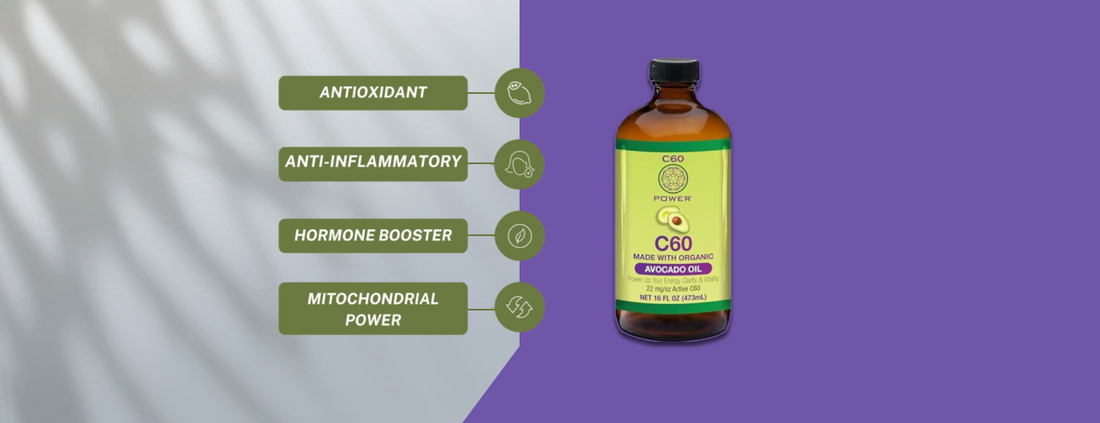
Carbon 60 (C60): The Antioxidant Powerhouse for Cellular Longevity & Health A Scientific Overview of its Origins, Mechanisms, and Health Benefits
Share
Carbon 60 (C60) is a naturally occurring molecule with an extraordinary ability to neutralize free radicals, support mitochondrial function, and optimize cellular health. Initially discovered in 1985 by scientists Harold Kroto, Robert Curl, and Richard Smalley, this spherical fullerene has since been hailed as one of the most powerful antioxidants known to science.
Research suggests that C60’s unique cage-like structure allows it to continuously scavenge free radicals without degrading, making it a highly efficient "electron donor" in the body. Its potential extends beyond basic antioxidant activity to immune modulation, cellular protection, and enhanced energy production.
This white paper explores the scientific background, biological mechanisms, and health applications of Carbon 60, with a particular focus on its role in longevity, inflammation control, and immune function.
1. The Discovery and Molecular Structure of Carbon 60
C60 belongs to a class of molecules known as fullerenes, a unique form of carbon arranged in a geodesic sphere, reminiscent of a soccer ball. This arrangement, made up of 60 carbon atoms, gives it remarkable stability and allows it to interact with biological systems in a highly selective and beneficial manner.
Historical Context
• Buckminster Fuller’s Influence (1979) – American architect and futurist Buckminster Fuller hypothesized the existence of a spherical carbon molecule, which was later named "Buckminsterfullerene" in his honor.
• Experimental Discovery (1985) – Scientists Kroto, Curl, and Smalley identified C60 during an experiment simulating carbon formation in interstellar space. Their findings earned them the 1996 Nobel Prize in Chemistry.
• Natural Occurrence – C60 is found in nature, originating from dying red giant stars, lightning strikes, and even in small amounts in the burnt wicks of candles.
2. The Mechanism of Action: How C60 Works at the Cellular Level
C60’s antioxidant and biological activity stems from its ability to neutralize oxidative stress by acting as a free radical scavenger. Unlike traditional antioxidants, which become unstable after donating an electron, C60 can reset itself, making it a highly efficient and reusable antioxidant.
Oxidative Stress and Free Radical Scavenging
• C60 acts as a "free radical sponge," neutralizing reactive oxygen species (ROS) and reactive nitrogen species (RNS) many times more effectively than Vitamin C or Vitamin E (Baati et al., 2012).
• Unlike synthetic antioxidants, C60 does not disrupt the normal redox balance of the body, meaning it won’t interfere with the hormetic benefits of exercise and metabolic function.
Mitochondrial Support & Energy Production
• The mitochondria are the powerhouses of the cell, but they also produce oxidative byproducts that can damage DNA and proteins.
• C60 has been shown to enhance mitochondrial efficiency by reducing oxidative stress, leading to improved ATP production and cellular energy (Fokina et al., 2019).
• This effect translates to increased endurance, faster recovery, and better cognitive function in both athletes and aging individuals.
3. The Antioxidant & Anti-Inflammatory Properties of C60
C60’s antioxidant properties far exceed conventional antioxidants. Comparative studies show that its electron donation capacity is several hundred times stronger than that of Vitamin C, Vitamin E, and CoQ10 (BuckyLab, 2015).
Inflammation Modulation
• Chronic inflammation is a driver of aging, cardiovascular disease, and neurodegenerative conditions.
• C60 reduces the production of pro-inflammatory cytokines such as TNF alpha and IL-6, leading to a balanced immune response (Gharbi et al., 2005).
Protection Against Environmental Toxins
• C60 may help neutralize heavy metals, pesticides, and environmental pollutants, reducing their oxidative impact on the body.
• Its lipophilic nature allows it to cross cell membranes, potentially offering protection at a deep intracellular level (Chen et al., 2020).
4. Immune System Benefits of C60
C60’s ability to modulate oxidative stress extends to the immune system, where it enhances both innate and adaptive immunity.
How C60 Enhances Immune Function
• Reduces oxidative burden on immune cells, improving their efficiency.
• Protects lymphocytes from oxidative damage, enhancing their ability to fight infections.
• May suppress excessive inflammation, helping those with autoimmune disorders or chronic inflammatory conditions.
A study on C60’s immune-boosting potential found that it could increase immune cell resilience while reducing unnecessary inflammatory responses (Tsuchiya et al., 2018).
5. Safety & Human Applications
Despite its potency, C60 has shown no toxicity in multiple animal and human studies. A groundbreaking 2012 study demonstrated that rats given C60 lived
90% longer than the control group, with no observed side effects (Baati et al., 2012).
Practical Applications
• Athletes: Increased energy, endurance, and recovery.
• Biohackers & Longevity Seekers: Cellular protection and aging defense. • Chronic Illness Patients: Reduction in inflammation and oxidative burden. Why C60 Purple Power?
Not all C60 products are created equal. C60 Purple Power sets itself apart by offering:
99.99% Pure Sublimated C60 (No solvents or contaminants) 3rd-Party Tested for Purity & Concentration
Organic Carrier Oils (Olive, Avocado, MCT)
Manufactured in an FDA-Compliant, GMP Facility
Conclusion: The Future of C60 in Health and Longevity
With its exceptional antioxidant properties, mitochondrial support, and immune-boosting benefits, Carbon 60 is one of the most promising compounds in anti-aging and cellular health research. As more clinical studies emerge, its potential applications in neurological health, cardiovascular function, and detoxification will likely expand.
For individuals seeking optimal health, energy, and longevity, C60 is a cutting-edge supplement backed by science.
References
1. Baati et al., 2012 – Prolonged lifespan study in rats.
2. Gharbi et al., 2005 – Anti-inflammatory effects of C60.
3. Tsuchiya et al., 2018 – Immune-boosting properties of C60.
4. Fokina et al., 2019 – Mitochondrial protection mechanisms. 5. Chen et al., 2020 – Detoxification potential of C60.
